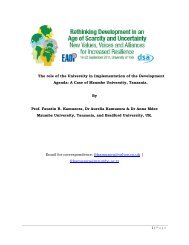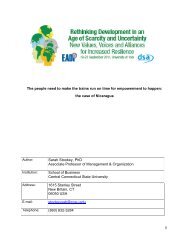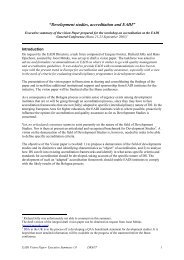Revenue Administration in Sub-Saharan Africa - International Tax ...
Revenue Administration in Sub-Saharan Africa - International Tax ...
Revenue Administration in Sub-Saharan Africa - International Tax ...
Create successful ePaper yourself
Turn your PDF publications into a flip-book with our unique Google optimized e-Paper software.
The ‘taxpayer segment’ model: A more recent development among a small number ofdeveloped countries (e.g. United States) has been to organize service and enforcementfunctions pr<strong>in</strong>cipally around segments of taxpayers (e.g. large bus<strong>in</strong>esses,small/medium bus<strong>in</strong>esses, <strong>in</strong>dividuals, etc.). The rationale for organiz<strong>in</strong>g thesefunctions around taxpayer segments is that each group of taxpayers has differentcharacteristics and tax compliance behaviors and, as a result, presents different risksto the revenue. In order to manage these risks effectively, the revenue body needs todevelop and implement strategies (e.g. law clarification, taxpayer education, improvedservice, more targeted audits) that are appropriate to the unique characteristics andcompliance issues presented by each group of taxpayers. <strong>Revenue</strong> bodies also need astructured approach to research<strong>in</strong>g and understand<strong>in</strong>g what these compliance issuesare. Proponents of the taxpayer segment type of structure contend that group<strong>in</strong>g keyfunctional activities with<strong>in</strong> a unified and dedicated management structure <strong>in</strong>creasesthe prospects of improv<strong>in</strong>g overall compliance levels. While application of thetaxpayer segment model is still <strong>in</strong> its early stages of use, many countries have createddedicated large taxpayer divisions/units.Source: OECD (2009)Survey results (Tables 6, 7 and Annex 2)•<strong>Revenue</strong> bodies are implement<strong>in</strong>g a wide range of organizational and<strong>in</strong>stitutional reforms with the aim of strengthen<strong>in</strong>g revenue mobilization,enhanc<strong>in</strong>g operational efficiency, and improv<strong>in</strong>g compliance andeffectiveness .36I n l<strong>in</strong>e with <strong>in</strong>ternational practice, none of the surveyedrevenue bodies is organized predom<strong>in</strong>antly by tax-type (except Ghana untilrecently).The most common model <strong>in</strong> the surveyed countries is hybrid, that isa model that conta<strong>in</strong>s a comb<strong>in</strong>ation of features associated with two or moremodels—mostly a comb<strong>in</strong>ation of functional-based and taxpayer segmentationfeatures .37• Domestic tax adm<strong>in</strong>istration has been <strong>in</strong>tegrated <strong>in</strong>to a s<strong>in</strong>gle department thatis organized on the basis of function/taxpayer segment—a recent keydevelopment <strong>in</strong> a number of countries such as Malawi, Kenya, Uganda,Rwanda and Zambia and is planned <strong>in</strong> Ghana. 38 Customs adm<strong>in</strong>istration is alsocommonly organized on the basis of key functions—trade facilitation,technical (orig<strong>in</strong>, valuation, classification and advance rul<strong>in</strong>gs), complianceand enforcement, and <strong>in</strong>ternational and regional coord<strong>in</strong>ation.• In most revenue bodies (except Ethiopia), tax and customs adm<strong>in</strong>istrationrema<strong>in</strong> dist<strong>in</strong>ct departments, only shar<strong>in</strong>g common support functions.• However, <strong>in</strong> a number of countries (Kenya, Rwanda, Tanzania, and Uganda),tax and customs departments also share common revenue adm<strong>in</strong>istrationfunctions <strong>in</strong> <strong>in</strong>vestigations and taxpayer services.36 Uganda was the first country <strong>in</strong> the region to set up a unified semi-autonomous revenue body <strong>in</strong> 1991. Ghana andBurundi are currently <strong>in</strong> the early phases of establish<strong>in</strong>g a semi-autonomous revenue body.37 Detailed organizational charts for selected revenue bodies are presented <strong>in</strong> Annex 1.38 Key domestic tax adm<strong>in</strong>istration functions <strong>in</strong>clude: taxpayer service; return process<strong>in</strong>g, tax account<strong>in</strong>g andpayment; collection enforcement; audit; and policy and legislation.30





